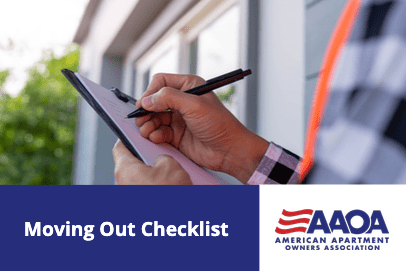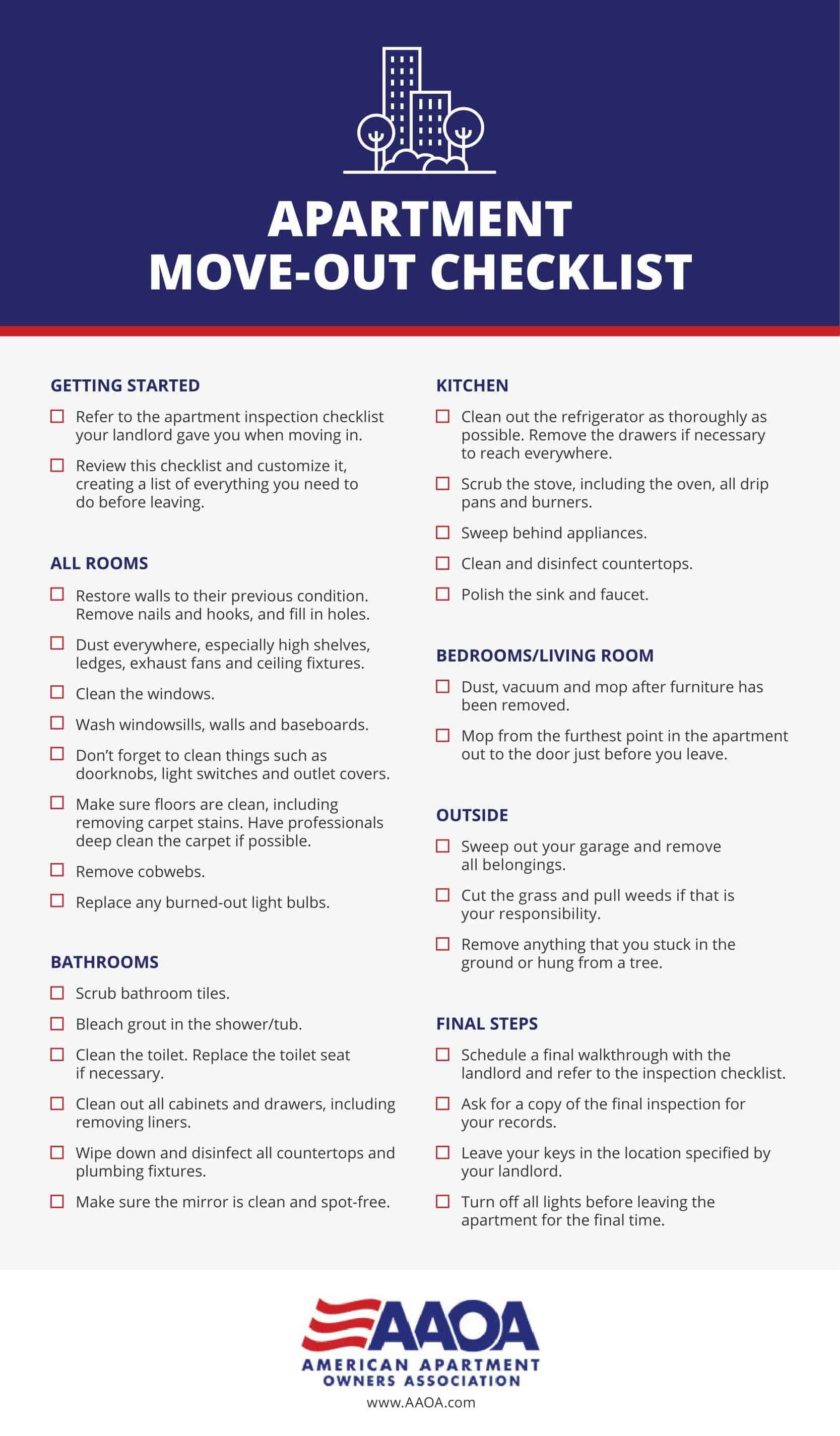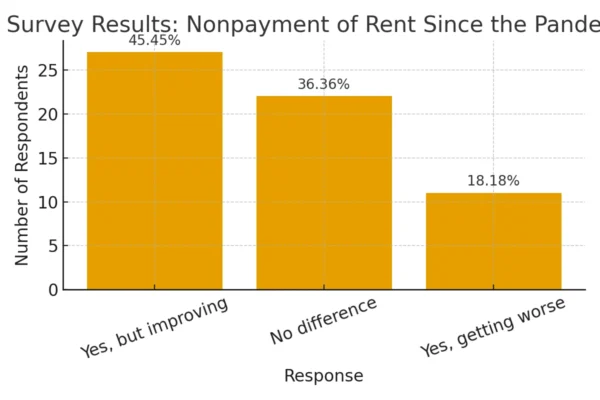Apartment Move-Out Checklist for Landlords
 As a landlord, time can slip by quickly. It may seem like just yesterday that you looked through a rental application, ran a tenant background check and rented out your apartment to your latest renter — but eventually, the time comes when your tenant is ready to move out and it’s time to begin the process all over again. The first thing to do is get your rental ready for the next prospective tenant by checking your apartment move-out checklist.
As a landlord, time can slip by quickly. It may seem like just yesterday that you looked through a rental application, ran a tenant background check and rented out your apartment to your latest renter — but eventually, the time comes when your tenant is ready to move out and it’s time to begin the process all over again. The first thing to do is get your rental ready for the next prospective tenant by checking your apartment move-out checklist.
Whether it was a one-year lease agreement or a longer stay, property management requires you to oversee how the most recent tenant may have left their mark on your property during their time there. It’s the landlord or property manager’s job to ensure that the unit is left in like-new condition for its next tenant.
After the current tenant has packed up all of their things, it’s time to pull out your comprehensive apartment move-out checklist to see what needs to be done to get the place ready. Once that’s done, you can restart the renting process with proper tenant screening and set a move-in date for your next renter.
What is an apartment move-out checklist?
An apartment move-out checklist, also known as a moving-out checklist, refers to a list with every item that needs to be checked for a comprehensive move-out inspection. This can include cleaning, move-out instructions and repercussions for missed items.
An apartment move-out checklist can be used by both landlords and tenants to maintain the rental’s overall property condition for new tenants. It’s also a great tool for a property with unique features (e.g., fireplaces, pools, etc.). This checklist can be tailored to verify that the property is properly cared for after move-out.
The best practice is to provide your tenants with a copy of the move-out checklist, so they are aware of how best to prepare for moving day. It’s important to keep it detailed with information about what will be checked, items that should remain (e.g., keys) and how items that are left behind will be handled. This will streamline the move-out process for both parties involved.
Why would a landlord need a move-out checklist?
Whether you own a condo, apartment or house, it’s essential that you have a checklist that can guarantee you won’t miss any potential damage that’s been done to the property. A thorough checklist protects you from hidden damage, as well as unforeseen cleaning costs.
For a landlord or property manager, this checklist also helps to prepare the unit for your next tenant, which will help build a good tenant-landlord relationship for the future. It tells you exactly what needs to be fixed or cleaned, which will then be taken from the previous tenant’s security deposit. If there are any security deposit disputes, this will be your number one piece of evidence — so always keep copies.
This checklist can also help you determine how long it will take to get the unit move-in ready for the next tenant — especially if repairs or additional cleanings need to be scheduled.
What should be included in your move-out checklist?
A move-out checklist needs to comprehensively cover what parts of your rental property need to be inspected to verify that it’s in good condition after move-out. This can be a daunting task for any landlord, so here are some handy tips to help get you started:
List every room and/or outdoor space on your property
From a studio to a four-bedroom, it’s always important to list every single room or outdoor space that exists on your property. This will help you organize your checklist for an easy inspection.
Determine the main subcategories for each space
Each indoor room may have identical features that appear throughout the unit. To save time, list them under each room on your list. Examples include:
- Walls
- Ceilings
- Floors
- Windows
- Window treatments
- Light fixtures
- Electrical outlets
- Smoke detectors
- Carbon monoxide detectors
- Doors
- Locks
Depending on state requirements, there may be additional home items that must be met in your rental unit. This is a good time to detail them in your apartment move-out checklist.
Identify unique features of each room
Does a bedroom have a fireplace? How many closets are there per room? Go through each room and list the items and features that are specific to that area.
For example, the kitchen is probably filled with appliances, such as a dishwasher, garbage disposal, sink, refrigerator, stovetop, oven, range hood, countertops, etc. These would only be listed under your kitchen checklist. For a room with a wood-burning fireplace, you might request the tenants clean and clear out debris before move-out. The checklist will help you verify whether they did this or not.
Additional items
Beyond what we listed above, you should also include miscellaneous items that need to be checked or handled during the move-out time. Below are some examples:
- Keys: All keys need to be returned to the landlord during move-out. Keep a list of what keys were given to the tenant and how many copies were made. This may include the apartment keys, mailbox keys and/or lobby keys.
- Utilities: When a new tenant arrives, they’ll need to transfer the utilities to their name. Give a reminder to your tenants that are moving out to remove their name from the utilities (e.g., gas, electricity, water, heat, etc.).
- Alarm codes: If your unit has an alarm system, verify that the codes are changed immediately upon tenant move-out for safety reasons.
- Unknown odors: If there’s an unidentified smell or odor in your apartment, you may be able to count that as excessive damage due to additional cleaning fees. If you can identify the odor as animal urine or smoking, it may also help determine if your tenant breached the lease agreement.
The ultimate goal is to get the property condition back to how it was before the tenant moved in. If you’re unsure how to start your checklist, don’t worry! AAOA can help with our sample move-out checklist guide for landlords.
Moving out checklist sample
This sample includes various areas and rooms that may exist on your property, as well as the steps to take if the tenant hasn’t completed proper move-out procedures. It’s best practice to provide each of your tenants with copies of this moving checklist to ensure they understand what is expected of them during the move-out process. This will also help prevent any additional repairs or cleanings that will need to be done before the next tenant moves in.
Getting started:
- Review this checklist and customize it, creating a list of everything you need to do before leaving.
All rooms:
- Restore walls to their previous condition. Remove nails and hooks, and fill in holes.
- Dust everywhere, especially high shelves, ledges, exhaust fans and ceiling fixtures.
- Clean the windows.
- Wash windowsills, walls and baseboards.
- Don’t forget to clean things such as doorknobs, light switches and outlet covers.
- Make sure floors are clean, including removing carpet stains. (You may need to hire professionals for a deep rental cleaning if there are tough stains in the carpeted areas.)
- Remove cobwebs.
- Replace any burned-out light bulbs.
Bathrooms
- Scrub bathroom tiles.
- Bleach grout in the shower/tub.
- Clean the toilet. Replace the toilet seat if necessary.
- Clean out all cabinets and drawers, including removing liners.
- Wipe down and disinfect all countertops and plumbing fixtures.
- Make sure the mirror is clean and spot-free.
Kitchen
- Clean out the refrigerator as thoroughly as possible. Remove the drawers if necessary to reach everywhere.
- Scrub the stove, including the oven, all drip pans and burners. These should all be degreased and cleared of debris.
- Sweep behind appliances.
- Clean and disinfect countertops.
- Polish the sink and faucet.
Living room
- Ensure all tenant furniture has been removed.
- Dust, vacuum and mop the floors.
- Mop from the furthest point in the apartment out to the door just before you leave.
Bedrooms
- Dust, vacuum and mop after the furniture has been removed.
- Ensure no items are left behind in closets.
Outside areas
- Remove any and all tenant belongings that may be left behind.
- Sweep out the garage.
- Cut the grass and pull weeds, if that is your responsibility.
- Remove anything that the tenant has stuck in the ground or hung from a tree.
Final steps
- Schedule a final walkthrough of the property and refer to each item on the inspection checklist.
- Provide a copy of the final inspection to the tenant for their records.
- Pick up keys in the location specified by the landlord or property manager in the lease agreement.
- Turn off all lights before leaving the apartment for the final time.
How does the checklist affect the security deposit?
A security deposit is a fixed amount of money (typically one month of rent) that the landlord or property manager can withhold if a tenant has damaged the property or missed any rental payments. If there aren’t any damages, the security deposit is returned in full to the tenant.
Landlords should conduct an apartment move-in checklist before and after renting a property as evidence for any property damage. This helps build proper documentation and written evidence that will determine what fees (if any) may be deducted from the tenant’s security deposit. In extreme cases, the entire security deposit may be withheld to cover damage and rental cleaning costs.
Certain fees can be deducted from the security deposit if there is damage beyond normal wear and tear from the tenant. In this case, it’s legally required that the landlord provides the reasons why portions (or all) of the security deposit were withheld. The apartment move-out checklist is a great way to document these reasons.
In some circumstances, the tenant or tenants may choose to dispute the distribution of security deposit funds. If the landlord and tenant can’t come to an agreement, the case may be escalated to a small claims court. In this scenario, the landlord must provide evidence of any damages done to the property by the tenant. A detailed checklist can count as additional proof.
Additional landlord resources: Join AAOA Today
A membership with American Apartment Owners Association gives you access to a variety of industry-leading tenant screening services, templates and rental documents to help you manage your business better. From listing to move-in to move-out, we’ve got you covered.
Ready to get started? Sign up for your account today!
AAOA’s landlord-tenant forms, tenant screening, resources and website are to be used as a guide only. The services our office provides access to are meant to supplement your education surrounding property management.














 Accessibility
Accessibility